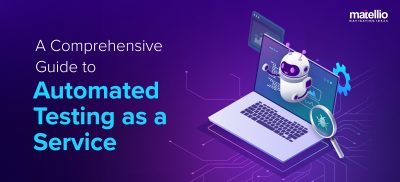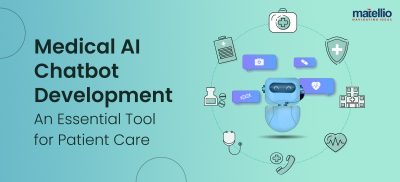
Semantic Automation! Is it some old stuff with a new package, or is it the next to best?
Let’s find out…
In recent years, many innovative automation concepts have come to pass; we have Cognitive Automation, Intelligent Automation, Hyper Automation, and Extreme Automation, and it hasn’t stopped! Each year, a new phrase is coined by an automation company or an industry analyst about updating Robotic Process Automation (RPA) more and more and, conveniently, generating some marketing buzz in the process. Semantic Automation is a phrase coined recently.
But what exactly is semantic Automation? Why should you care about it?
Semantic Automation is the next technology to dramatically advance Automation after robotic process automation (RPA) and Artificial intelligence (AI) development services. It increases the dependability of Automation, streamlines automation development, and broadens the use cases for Automation.
In this blog article, we’ll go into greater detail about semantic Automation and how it’s essential to establishing completely automated businesses. Further, we will also go through how you can begin participating in this journey.
Semantic Automation is when user agents like a web browser generate meaning and relationships, which could be unclear or sometimes incorrect. In a nutshell, it involves using algorithms to try to mend things that are certainly broken. It’s computers making educated guesses! Let’s explain to you with a live example, It is best illustrated by the “Did you mean…” feature on Google, where you sometimes search a term, but Google cannot get what you are asking for and make some assumptions that may or may not be right for what you want to see. It’s a big part of how iPhone’s Siri (a great example of conversational AI services) Can use a ton of data and attempt to understand exactly what you are asking it to do. When a machine guesses, the results can often be what you weren’t wanting. But something is better than nothing. Right? Semantic technology uses formal semantics (the study of reference, meaning, or truth) to aid AI Development Services in comprehending language and processing data similar to humans, thereby storing, managing, and retrieving information based on the significance and logical linkages. Semantic Automation can benefit employees with repetitive as well as semi-technical tasks. The process of evaluating meaning and intent from words is semantic analysis. Semantic Automation augments tools like RPA and intelligent Automation with AI-powered semantic analysis. Software bots, often known as “digital workers,” can better comprehend the context of the operations in which they are used. Semantic Automation enables software robots to interact with texts and user interfaces at a higher understanding level than humans can, by integrating semantic understanding across our platform. Software robots comprehend the business context of everything you do rather than just observing the design and style of a document. By enabling developers to concentrate on the business issue they are attempting to address, software robots with semantic capabilities will allow them to be far more productive. Today, Semantic technology and semantic graph databases are being used by many enterprises to manage their content, repurpose and reuse information, reduce expenses, and create new revenue streams. Semantic Automation provides numerous benefits to businesses, including helping them understand their customer base, cut expenses, and boost productivity by automating routine processes. Let’s go through some of them one by one: Semantic Automation enables businesses to automate previously too difficult or time-consuming operations to be mechanized using conventional methods. For instance, a business might utilize semantic Automation to evaluate client feedback and swiftly spot recurring themes or problems that require attention. The company can increase client satisfaction and loyalty with prompt and effective customer service. Another benefit of semantic Automation is that it can help businesses to improve their decision-making processes. Analyzing large amounts of data and using Machine Learning solutions to identify patterns and trends can provide businesses with insights and recommendations that they might have yet to obtain using traditional methods. This can help companies to make more informed decisions, improving efficiency and productivity. In addition to automating complex jobs and enhancing decision-making procedures, Semantic Automation can also assist organizations in keeping up with the quickly altering market demands. Businesses can transform their operations in real-time and remain competitive by promptly assessing and interpreting new data. This enables them to respond to changing situations. Semantic Automation is advantageous for large-scale companies, but also small and medium-sized businesses can also use this technology to boost productivity and streamline their processes. For instance, a small business may employ semantic Automation to examine sales data and spot trends in consumer spending patterns. This could assist the retailer in selecting the right products to carry, resulting in higher sales and profitability. It can take a long time to manually create connections between documents, data, apps, and processes. Semantic Automation can minimize the number of workflow steps requiring coding. Semantic Automation can endure many target app changes, even those that would typically cause Automation to fail. Robots can continue to function and adapt to the changed condition of the app. By automating data analysis and machine learning techniques powered by AI devices like Google Assistant, semantic Automation also aids in lowering fraud, customer service, and other activities. Without an in-depth understanding of the underlying technology, business users can use Semantic Automation to complete jobs more quickly or create their Automation. Despite these many benefits of Semantic Automation, it’s important to remember that it is not a replacement for human workers. Instead, it should be viewed as a tool that can help businesses to optimize their operations and free up time and resources for more complex and creative tasks. In addition to carrying out its duty, an RPA robot with semantic understanding will comprehend what it is doing. It also understands the environment in which it operates and sees the data, application displays, and documents. Additionally, it will instantly comprehend the ERP system’s user interface, enabling it to swiftly and easily translate the information fields from the pdf order form to the equivalent areas in the UI. Consequently, the “Ultimate Copy-Paste” experience is made possible by a Semantic Understanding of RPA robots. Additionally, because the robot is aware that it is carrying out an order entry process, it can deal with some common exception scenarios that can happen in this type of business process (such as product codes unknown, required delivery date is impractical, etc.) and can also adapt to changes in the process more effectively (e.g., input screen of the ERP system is updated). Such features would significantly increase the dependability of RPA robots and significantly lower the development and maintenance costs. As a result, semantic Automation has the potential to substantially expand the applicability of RPA, which might be a game changer. Also Read: What is Robotic Process Automation And How Can You Get Started With It? The study of semantic AI uses human logic to derive meaning from data, not just through statistics alone. Let’s go through some of the use cases for Semantic Automation: There are many different forms of documentation, including invoices, reports, and other types. Extracting data from each one of them can be a tricky task. Moreover, documents of the same type are available in various formats. The process becomes further complicated by distorted photos, blurry text, inconsistent handwriting, or color variations. Bots with a semantic understanding improve the precision of data extraction by reading and analyzing unstructured data from documents with various formats or layouts. Semantic Automation helps RPA bots think more like people, enhancing their sentiment analysis capacity. Hence, machines might assess human emotions before responding. Think about an insured who got recently hurt in a severe car accident. For claims processing to be as efficient as possible, the chatbot must understand the emotional context that the insured experiences. Additionally, because these tools can predict human emotions more precisely, they can aid companies in their marketing and sales initiatives. Also Read: AI-driven Sentiment Analysis- Benefits, Use cases and Implementation It’s challenging for machines to converse in a way like humans do. This is because natural languages can be quite erratic and require intuition derived from lived human experience. It is not surprising that chatbots frequently fail to understand what the user genuinely wants them to accomplish when you consider the peculiarities of informal languages, such as typos, missing punctuation, abbreviations, etc. Bots with semantic comprehension and expertise in domain-specific languages may comprehend the context of discussions and respond to questions by applying logic and common sense. When implemented properly, Semantic Automation can produce astonishing outcomes. It is being utilized more and more because of its discerning abilities: By handling these duties digitally, human workers can focus on complicated jobs that call for communication, negotiation, leadership, entrepreneurship, emotional intelligence, and social awareness. Institutions can use cutting-edge technology to be competitive in a world that prioritizes digital transformation by investing in an intelligent automation platform. What is Semantic Automation?
Benefits of Semantic Automation to Businesses

Efficient and Saves Time
Decision Making
Prompt Evaluation
Fast Development
Superior Reliability
Optimize Operations

What Happens When We Combine RPA With Semantic Understanding?
Some Use Cases for Semantic Automation

Document Processing
Sentiment Analysis
Chatbots

Semantic Automation: A Scaling Approach


